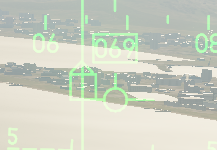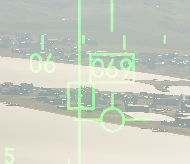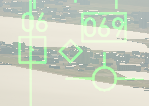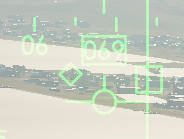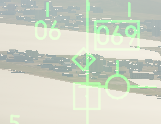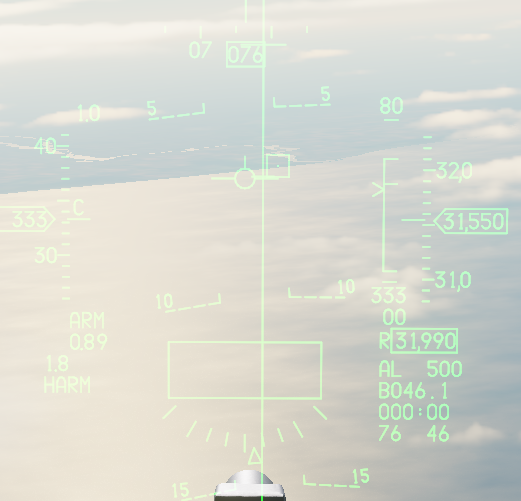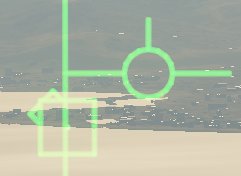-
Posts
7593 -
Joined
-
Last visited
-
Days Won
3
Content Type
Profiles
Forums
Events
Everything posted by Frederf
-
You can move bug around while missiles are in flight (RWS or TWS) and it will show you the missile info for that target. If multiple missiles are to a single target it will be last fired I think. The colors/symbols for targets when missile goes autonomous should work the same in all modes. The TMS right (short) shortcut to elevate all TWS tanks to system is helpful. TWS should have much crappier track compared to SAM. It's good for long range monitoring a busy picture and when shooting at 3+ targets simultaneously, not much else.
-
-
Are these old mission files? Sometimes the loadout objects defined in the mission point to old stuff where new missions don't have that issue.
-

correct as is Laser Code Set to Zero at Start
Frederf replied to sbower's topic in Bugs and Problems
The real airplane OFP defaults to 1688 (I think) if not supplied by DTC. Zero isn't a valid code to exist in that data spot. -

fixed GBU 24 falling way short? Bug or user error?
Frederf replied to Fulcrumkiller31's topic in Bugs and Problems
I'll make a track when I get home- 24 replies
-
- due to laser designation range
- reported
- (and 1 more)
-

fixed GBU 24 falling way short? Bug or user error?
Frederf replied to Fulcrumkiller31's topic in Bugs and Problems
PW3 are different than PW2. The weapon should fly in a "bump up" glide to extend its range regardless of laser energy and should arrive to target area (or beyond) if not guided. The weapon has an INS, barometric sensor, digital autopilot. It decides what delivery profile to do based on sensed data on release: loft-level, dive, and I think a third one. It has a break level ceiling of I think 15,000' PA.- 24 replies
-
- 3
-

-
- due to laser designation range
- reported
- (and 1 more)
-
The circle means you are entering max toss range which is usually 4-6 miles. That's not the release point. The solution cue will march down the ASL (and timer reach zero) twice as you approach. Ignore the toss stuff unless you are lofting. After thr circle disappears the you are "game on" to release. Manual range is the caret and scale in miles. Staple top and bottom is max toss to level. Loft release will happen somewhere in the staple range, level at bottom, and dive below. ISM PRE and IAM VIS post designate have ASL for JDAM and WCMD if that's what you mean by "attack vector".
-

reported earlier FCR GM Problems. Are these bugs??
Frederf replied to RPY Variable's topic in Bugs and Problems
1. I'm not sure. I would hope that the previous FOV imagery (except switching from DBS2 to NORM) would persist into the next FOV expansion. The most likely continuum of imagery would be NORM->EXP since they're essentially the same. Moving into DBS or between DBS may be less likely for a continuation of imagery. Nothing in the radar description mentions blanking of imagery when changing FOVs (or the inverse). I do know that the scale can change without changing FOV (DCS reverts to NORM). Also it should be possible to change GM/GMT/SEA mode while in FTT without interrupting FTT (DCS drops FTT and reverts to NORM). 2. FCR mark with FZ is an interesting case. Markpoint mechanization says that you can't FCR mark unless "FCR is tracking" which might mean FTT/MTT (how DCS seems to interpret it). In which case TMS forward in FZ is not going to make a mark point. I tried it in DCS and on first designate in FCR GM FZ mark it erases the map (empty gray bg), second puts a square/diamond* at cursors (empty gray bg), third records a mark (empty black bg) and then 5sec later returns to empty gray bg. So it's recording a mark point with a TMS forward designation after you establish a hollow square at cursor intersection and will cause the MFD to go true black background for 5 seconds on the actual record of the mark. The behavior seems to vary based on if your point is a square or a diamond*. Just keep mashing TMS forward until you get a mark recorded (watch DED). I think it's not accurate behavior but realistic behavior might be less useful. My understanding is that designating in FZ should cause GM to enter FTT which won't be frozen any more. Map will show the old picture for 10 seconds (or 10 degrees of turn) and then show the live FTT view (which has no map picture, just the solid diamond at cursor with a pure black background). Right now DCS isn't doing this automatic image timeout and only displays the true FTT with a manual designation again. If FTT drops track it would return to search. So once in FTT FCR would be considered tracking and then your second (and third, fourth, fifth, sixth) TMS forward would record a mark at the tracked FTT target. To target a different location you'd have to return to search (re-enter FZ if desired) then go track something else and designate then designate again to record the next mark point. 3. Mark automatically picks marking sensor based on sensor status. Because FCR wasn't tracking it's going to pick HUD as the default initialized sensor. Notably this really sucks when you had something on FCR GM that you wanted to mark. No worries, either FTT a target before pressing ICP MARK or allow the sensor to initialize to HUD and DED SEQ to the FCR sensor and then track it/ mark it. *NOTE: When you designate FCR GM you'll get either a hollow square (not tracking) or solid diamond (tracking). A hollow square indicates that the radar is in process or failing to track that spot. If you pick the "radar shadow" backside of a mountain you won't get track and after a few seconds it will fail back to search. You can still mark a hollow square but you have to do it before the track attempt fails. Presumably this doesn't have the same accuracy of an actual radar track mark point in real life because there's no radar range/elevation data. I think in real life steerpoint elevation is recorded as equal to current steerpoint (so inaccurate) if it can't actually range the ground. -
It's not a bug in that it's not counter to programmer intent. The slider is not designed to do anything with external fuel tanks, just internal fuel. There's no way intended to fill external tanks by ground service. The fact that there is "back flow" to external while filling internal (specific F-16 behavior) is is an unintended side effect (accident) due to how the system is modeled. When being filled the F-16 is partitioning the incoming fuel in a 1:1 ratio between internal and bags and the refueling continues until internal reaches target. Whether this fills bags depends on space in bags, how much current internal fuel fraction is, and how much much final internal fuel fraction is.
-
There are some subtleties to the language regarding F-16 locations that's not quite right. In an A-G preplanned mode with direct aimpoint sighting the steerpoint and target are coincident. The steerpoint does and should move. What's confusing is that HUD (HMCS) symbols are layered with occlusion priority so sometimes the diamond can't be seen because it's "under" or occluded by the TD box. The situation we get in DCS where you can see the "diamond in the box with dot" should never happen because if TD and diamond are together then diamond is not visible. No diamonds are displayed in preplanned modes except when they denote the RP (VRP) and is not a steerpoint or when it denotes IP (VIP) when it is a steerpoint. In VIP case the diamond will be steerpoint but TD box won't be so they can co-exist. The TD box will still occlude IP/STPT diamond if they overlap in the HUD. If you are in an A-G preplanned mode and don't have VIP or VRP enabled and see a diamond in your HUD/HMCS it is a bug. Because DCS has an error where you see the diamond in the wrong spot in CCRP I'm using CCRP VIP to demonstrate symbol occlusion. I have placed TGT (TD box) between me and the diamond (1nm closer) but since it is at 0' and I have altitude diamond and TD are not overlapping. Next I will raise up the target by a few hundred feet so it overlaps (lies along same LOS) and you'll see TD occlude diamond. Note that it doesn't matter which symbol is physically closer. Even if TD is physically farther away than diamond it will have higher priority. null Raised 150', half of diamond occluded Raised 300', all of diamond occluded. This is what should happen at all times when TD and diamond are in the same place. Now I'll show how normal CCRP is wrong by slewing TD box around and seeing that diamond remains in one place (it should move and always be "under" the TD box). It does occlude correctly though. See how slewing steerpoint doesn't move diamond? This is wrong behavior. In CCRP you are absolutely moving the steerpoint (well you're not actually moving it but you're adding cursor corrections and the diamond is placed at steerpoint plus cursor correction, same result) and thus the diamond. Because in direct sighting the TGT is the STPT the TD box will be where the steerpoint is so TD box and diamond will always perfectly align and diamond will never be visible. Anyway, look at HARM symbology. First we look at normal HARM POS (EOM) HUD which is designated without HAD (simply current STPT) Steerpoint = target so TD box is right over steerpoint ahead, perfectly normal. You should be able to slew the STPT/TD using HUD SOI or FCR SOI just like CCRP and we can't in this version. Now we try designating using HAD... This is nonsense. Diamond doesn't belong on HUD at all here in any position (well, it should be under TD box thus invisible). Steerpoint has been moved by HAD/HTS in a similar way that it would be moved by TGP/Litening with normal bombs. Notice how designating with HAD will change the bearing to NAV destination on HSI between your knees, again because it is moving the steerpoint so make sure to CZ after using HARMs in this way.
-
A lot of times a two ship would perform a coordinated attack. Each plane would do a different templated attack path. The differences in lead and wing's paths after the action point developed deconfliction (usually time). The element would fly in formation until action (sometimes a radio call literally "action") where they would split into their individual routes. Checking off (check turn is a turn to a relative heading) is a way for getting some lateral distance for geometry which often helped the egress turn from being 180. E.g. a 15 check over 15nm gives 3.9nm separation. It's also possible for one jet to check 0 (IP direct to target) while the other offsets. Naturally a single jet could do these maneuvers but the value of deconflicting from wingman is not applicable. This attack geometry would apply equally to computed or manual bombing as it's to get the jet into position to do the actual delivery.
-
I'd watch the track but I don't have Syria installed. HARM delivery POS/DL is an A-G preplanned mode (like CCRP) which should mean that the TD box and the steerpoint are one and the same (except HRMVRP/HRMVIP which can have the TDB and diamond displaced). In preplanned AG modes it's normally the case that slewing TD to a target also moves the steerpoint. It's basically the reason "CZ" function exists. If the system is modeling HARM POS like CCRP then the steerpoint moving to the target is correct behavior. HARM-HAS is a visual delivery mode so you should see the diamond in there (similar CCIP). Seeing the diamond and TD box at the same time in a preplanned mode at any time* is a bug. In a simple test I had diamond in HUD FOV and designated HAD which deleted the diamond and put TD box on HAD threat. The initial pre-HAD-designation is (I think) wrong. System is in HARM POS delivery mode which would be directed toward steerpoint. Designating on HAD isn't its own mode or anything. It's just a way to get the steerpoint moved. HAD is an optional sensor for HARM POS just like TGP is an optional sensor for CCRP. TD box should exist before HAD designation. And in both cases TD box covers up the diamond because steerpoint is target is SPI. Also "STP" in sighting point rotary should say "TGT" because this isn't a NAV or FIX mode. Parts that are wrong is that HAD (POS) designation should break on steerpoint reset/change. You cannot have a HAD designation and change steerpoint. By changing or CZing or switching visual AG, etc. will cause the designation to drop. *The only time diamond and TD should both be displayed at the same time is VIP/VRP such that diamond and TD box are not coincident.
-

cannot reproduce and missing track file Weapon won't release
Frederf replied to Scendore's topic in DCS: F-16C Viper
Yes, set them to BORE in SMS (or hold enable button to swap to BORE) and hold uncage and then press WR -
The tracer effect was based on a video in humid conditions where the rounds left a vapor trail. You can bring the PGU-15 load they just are kinda boring.
-
If you want precision use the XZ grid which is meters (tenths of meters?) and do trig on it. That's how I did Mirage bombing forever. I know they have added a new feature to Mirage to auto-input the PI data. With F-16 it's more complicated since it has both OAP and IP/RP offset so Mirage solution doesn't do everything. To really get all three values from editor would need some kind of custom solution. Steerpoints can also be designated "TGT" in the mission planning software (not cockpit except VIP/VRP) with "IP" being the one before "TGT" which changes their symbols from circles to triangle/square respectively. I guess that could just be based on the waypoint name field.
-
It's just an inaccurate label. They should change "NH" to "FF" in the briefing template and be done. It's impossible to report QNH as a single number because there are an infinite number of QNHs depending on where you mean. If they wanted to report a particular number it would have to be calculated based on single player spawn location or something. In multiplayer everyone would need a different calculated number.
-

How are the radio and the navigation system simulated?
Frederf replied to IDontLikeBigbrother's topic in DCS: Mosquito FB VI
Look for the yellow corners on the boxes of the bombs in loadout. -
TGP should always break track and follow FCR when SOI (and slewed IIRC). The "jiggle the sighting point" workaround is a workaround. SPI handling is automatic in the F-16 and with rare exception follows the SOI'd sensor.
-
I see it too. Looks like the plain weapon designator (1.06um) is a visible spot under NVG. I don't know if 1.06um should be visible under NVG. It would depend how far into longer wavelengths the goggles are sensitive. That's not the pointer though. I checked with A-10C2, designator gives a point fuzzball on the ground, pointer is a visible line connecting pod with ground.
-

Upcoming Updates Video (19 Aug) on Spotlight Scan Radar Mode
Frederf replied to GrEaSeLiTeNiN's topic in DCS: F-16C Viper
It's just the natural flow because you're holding designate and slewing to find the best place to release the switch. Ergonomically it sort of how TMS release works with TGP point and Maverick track. Rapid radar energy in a small space will find stuff that infrequent radar energy won't. Plus you should have a high quality track forming from spotlight that can be tracked right away where a single search hit would have to go through a longer and fallible acquisition sequence. -
Those are legal minimum service areas. It doesn't only work there but must work in at least those areas. In reality signals are usually received valid well beyond those limits.
-
Just like they taught us in a cessna, modify your headings to do the same ground track as no wind. Note the WCA on initial and assume it gets bigger when slower. If pattern is on winward side and crosswind is windward side I might consider putting key point more upwind but just more throttle and more base turn G should suffice.




